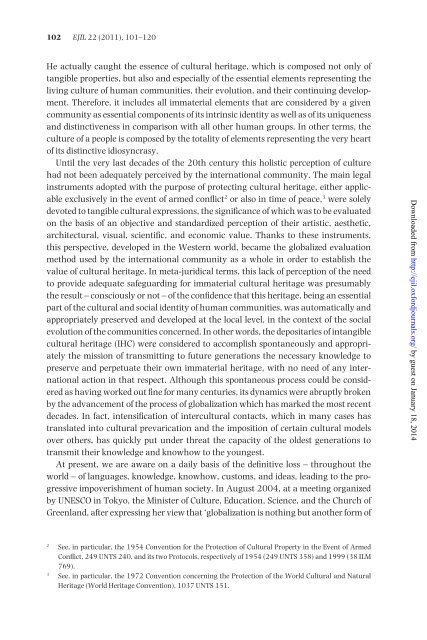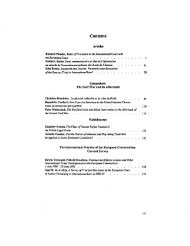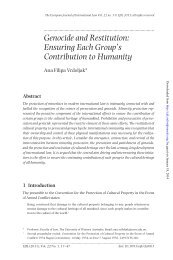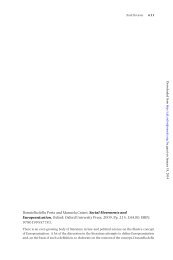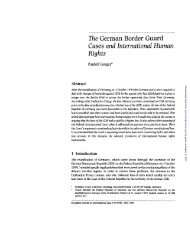Intangible Cultural Heritage - European Journal of International Law
Intangible Cultural Heritage - European Journal of International Law
Intangible Cultural Heritage - European Journal of International Law
Create successful ePaper yourself
Turn your PDF publications into a flip-book with our unique Google optimized e-Paper software.
102 EJIL 22 (2011), 101–120<br />
He actually caught the essence <strong>of</strong> cultural heritage, which is composed not only <strong>of</strong><br />
tangible properties, but also and especially <strong>of</strong> the essential elements representing the<br />
living culture <strong>of</strong> human communities, their evolution, and their continuing development.<br />
Therefore, it includes all immaterial elements that are considered by a given<br />
community as essential components <strong>of</strong> its intrinsic identity as well as <strong>of</strong> its uniqueness<br />
and distinctiveness in comparison with all other human groups. In other terms, the<br />
culture <strong>of</strong> a people is composed by the totality <strong>of</strong> elements representing the very heart<br />
<strong>of</strong> its distinctive idiosyncrasy.<br />
Until the very last decades <strong>of</strong> the 20th century this holistic perception <strong>of</strong> culture<br />
had not been adequately perceived by the international community. The main legal<br />
instruments adopted with the purpose <strong>of</strong> protecting cultural heritage, either applicable<br />
exclusively in the event <strong>of</strong> armed conflict 2 or also in time <strong>of</strong> peace, 3 were solely<br />
devoted to tangible cultural expressions, the significance <strong>of</strong> which was to be evaluated<br />
on the basis <strong>of</strong> an objective and standardized perception <strong>of</strong> their artistic, aesthetic,<br />
architectural, visual, scientific, and economic value. Thanks to these instruments,<br />
this perspective, developed in the Western world, became the globalized evaluation<br />
method used by the international community as a whole in order to establish the<br />
value <strong>of</strong> cultural heritage. In meta-juridical terms, this lack <strong>of</strong> perception <strong>of</strong> the need<br />
to provide adequate safeguarding for immaterial cultural heritage was presumably<br />
the result – consciously or not – <strong>of</strong> the confidence that this heritage, being an essential<br />
part <strong>of</strong> the cultural and social identity <strong>of</strong> human communities, was automatically and<br />
appropriately preserved and developed at the local level, in the context <strong>of</strong> the social<br />
evolution <strong>of</strong> the communities concerned. In other words, the depositaries <strong>of</strong> intangible<br />
cultural heritage (IHC) were considered to accomplish spontaneously and appropriately<br />
the mission <strong>of</strong> transmitting to future generations the necessary knowledge to<br />
preserve and perpetuate their own immaterial heritage, with no need <strong>of</strong> any international<br />
action in that respect. Although this spontaneous process could be considered<br />
as having worked out fine for many centuries, its dynamics were abruptly broken<br />
by the advancement <strong>of</strong> the process <strong>of</strong> globalization which has marked the most recent<br />
decades. In fact, intensification <strong>of</strong> intercultural contacts, which in many cases has<br />
translated into cultural prevarication and the imposition <strong>of</strong> certain cultural models<br />
over others, has quickly put under threat the capacity <strong>of</strong> the oldest generations to<br />
transmit their knowledge and knowhow to the youngest.<br />
At present, we are aware on a daily basis <strong>of</strong> the definitive loss – throughout the<br />
world – <strong>of</strong> languages, knowledge, knowhow, customs, and ideas, leading to the progressive<br />
impoverishment <strong>of</strong> human society. In August 2004, at a meeting organized<br />
by UNESCO in Tokyo, the Minister <strong>of</strong> Culture, Education, Science, and the Church <strong>of</strong><br />
Greenland, after expressing her view that ‘globalization is nothing but another form <strong>of</strong><br />
Downloaded from http://ejil.oxfordjournals.org/ by guest on January 18, 2014<br />
2<br />
See, in particular, the 1954 Convention for the Protection <strong>of</strong> <strong>Cultural</strong> Property in the Event <strong>of</strong> Armed<br />
Conflict, 249 UNTS 240, and its two Protocols, respectively <strong>of</strong> 1954 (249 UNTS 358) and 1999 (38 ILM<br />
769).<br />
3<br />
See, in particular, the 1972 Convention concerning the Protection <strong>of</strong> the World <strong>Cultural</strong> and Natural<br />
<strong>Heritage</strong> (World <strong>Heritage</strong> Convention), 1037 UNTS 151.


